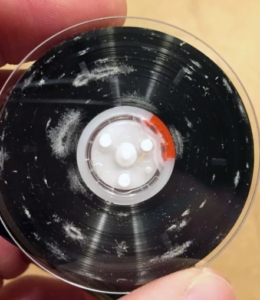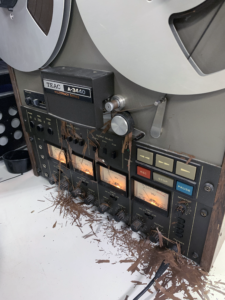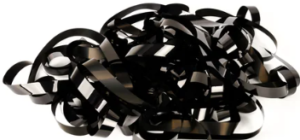WHAT IS STICKY SHED SYNDROME, ANYHOW?

Sticky Shed Syndrome (SSS) took the magnetic recording industry by surprise when first encountered in the early 1980s. It was never an issue until tapes were being brought out of storage and refused to play reliably without breaking.
SSS in many cases does not announce its presence until an affected reel is played. However, for video tapes it is common to see a mold-like appearance visible through the cassette transparancy.
IS THERE A FIX FOR SSS?
There is a method that is claimed to recover SSS tapes where you bake the tape for a defined thermal profile. You can google “sticky shed syndrome baking” for many explanations of the method. I have tried it in the past without success.
In 2020 a client brought me two 10” reel-to-reel audio MAG tapes which turned out to have SSS. I informed the client about the malady and what is often claimed to be a fix and offered to let him take the tapes back to bake them himself. He took me up on the offer and brought them back later that week. However, when I then played the tapes, they shed their magnetic material worse than could be imagined. I literally had to sweep the droppings up off the table.
I informed the client about the malady and what is often claimed to be a fix and offered to let him take the tapes back to bake them himself. He took me up on the offer and brought them back later that week. However, when I then played the tapes, they shed their magnetic material worse than could be imagined. I literally had to sweep the droppings up off the table.
Because of the nature of a reel-to-reel tape deck, the droppings were harmless. For video, however, the droppings would be hazardous to the video tape deck health.
I HAVE AN ALTERNATIVE FIX
There is a fix that nobody talks about, or at least is never presented on the internet. The problem is that it is so incredibly labor intense that there is no way anyone in his right mind would want to do it. However, it is possible that some may be gluttons for punishment or maybe have an incredibly important memory to salvage. For those persons I will go ahead and explain my method.
One must literally spool out the tape by hand making a pile of spaghetti that might (or certainly will) tangle upon re-spooling back. The reason I think this would work (apart from a tangled mess) is because of the nature of SSS. As you spool off tape by hand you can hear crackling as minor bonding between adjacent tape layers break their adhesion to one another. But you will come to an occasional binding where it will not break with casual spooling. When you come to one of those bindings you can work with it, You can wiggle and tweaking the tape until it breaks the binding and again spools off again with more crackling from mini-adhesion breaks.
might (or certainly will) tangle upon re-spooling back. The reason I think this would work (apart from a tangled mess) is because of the nature of SSS. As you spool off tape by hand you can hear crackling as minor bonding between adjacent tape layers break their adhesion to one another. But you will come to an occasional binding where it will not break with casual spooling. When you come to one of those bindings you can work with it, You can wiggle and tweaking the tape until it breaks the binding and again spools off again with more crackling from mini-adhesion breaks.
When you have completely spooled off the entire tape onto (a recently swept) floor, you can then collect it up for baking following the profile suggested by the experts.
The theory behind this is that for a machine to spool off tape from a supply reel to a take-up reel, it torques in one direction with a constant torque. When it comes to a serious binding, it has a tangential velocity that is significant (whether in PLAY or, more-so, in FF). The transport then stops causing a significant negative acceleration. That is, the tape transport velocity transitions from X meters per second to zero meters per second in something on the order of maybe 10 milliseconds.
Recall from high school physics that a force is equal to a mass times its acceleration.
F=ma
The shorter the time to transition from X meters per second to zero (the larger the negative acceleration), the greater the resulting force.
In a machine transport mode, there is no forgiveness. The machine just pulls and what happens, happens. However, when someone like you or I spool off the tape into spaghetti on the floor, we are free to extend forgiveness to the tape. When we come to a serious binding we play with it, giggling it in different directions with a gentle force. But even with this the tape may break so be careful.
THE PRACTICAL ASPECT
Spooling off an entire reel of tape to the floor, it is GUARANTEEDED it would tangle upon an attempt to re-spool. However, you could spool off just a little spaghetti and the re-spool before spooling off the next round of spaghetti.
It would be nice to have a mechanical advantage somewhere in this process but you can’t afford it. Think of it like digging a ditch through an area where you know there is an underground conduit. If the backhoe scratches the conduit you are toast. But with two people executing this SSS fix would go faster since one could be constantly re-spooling while the other is spooling.
